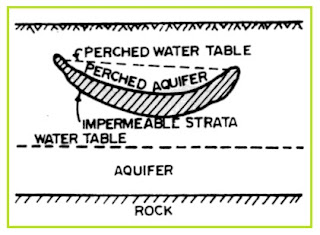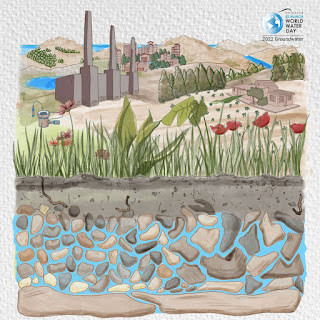Search This Blog
Most Popular
Categories
- Building Construction (87)
- Building Materials (85)
- Columns (2)
- Concrete Beam (3)
- Concrete Construction Techniques (6)
- Concrete Mix Design (15)
- Concrete Repair (14)
- Concrete Slab (11)
- Construction Equipment (17)
- Construction News (7)
- Design of Structures (19)
- Engineering Drawing (1)
- Estimation (3)
- Geotechnical engineering (26)
- Highway Engineering (11)
- Innovations (34)
- Material Testing (11)
- Matrix Analysis of Structures (2)
- Mechanical Engineering (3)
- Strength of Materials (2)
- Structural Analysis (13)
- Structural Design (24)
- Structures (17)
- Transportation Engineering (9)
What is Groundwater Hydrology?
Team Prodyogi
December 16, 2022
Groundwater hydrology is the science of the occurrence, distribution, and movement of water below the surface of the earth. Do you know that the largest available source of fresh water lies underground?
If the field coefficient permeability is k and the thickness of the aquifer is B, then the coefficient of transmissibility is given by:
This is why we and why the world is talking and taking measures to save the soil and hence the water beneath. This means the total groundwater potential is estimated to be one-third the capacity of oceans.
In this article, you will learn the sources and features of groundwater hydrology and related definitions.
What are the Sources of Groundwater precipitation?
The main source of groundwater is precipitation. Precipitation is defined as the process in which water is released from clouds in the form of rain, snow, sleet, or hail. As per the geography of the United States, 25 percent of precipitation becomes groundwater.
During precipitation, a portion of rain falling on the earth's surface infiltrates into the ground, travels through several impervious layers, and reaches the groundwater.
In addition to precipitation, groundwater can be formed from intrusive rocks that are lying deep below the earth or from the water that is trapped in sedimentary rocks. In reality, these sources provide smaller quantity groundwater and are highly mineralized and unsuitable for use.
How to Discharge Groundwater?
Groundwater can be discharged in two ways:
- Natural Way
- Artificial Way
The natural discharge of groundwater includes lakes, reservoirs, rivers, oceans, and springs. Pumping groundwater through wells is the major artificial discharge of groundwater.
Groundwater Aquifers
The study of groundwater and groundwater aquifers requires knowledge of aquifers and their types. An aquifer is a geological formation - an underground layer of water-bearing within a layer of permeable rock, or unconsolidated materials like gravel, sand, or silt. There are two types of aquifers:
- Unconfined aquifer
- Confined aquifer
1. Unconfined Aquifers or Non-Artesian Aquifer
- Also called a free, phreatic, or non-artesian aquifer.
- It is an aquifer in which the water table serves as the upper surface of the zone of saturation (Figure 2 (A)).
- It has a water table level in an undulating form as shown in the figure below.
- A rise or fall in the water table implies a corresponding change in the volume of water stored in the unconfined aquifer.
 |
| Fig.2. Unconfined and Confined Aquifer |
2. Confined Aquifer or Artesian Aquifer
- The groundwater is within impermeable strata and confined under a pressure greater than atmospheric pressure.
- The concept is better understood by comparing a confined aquifer with pipelines.
- A well is used to penetrate an artesian well for discharge. During the process, as shown in the figure-2 above, the water level rises to the level of the local static pressure or artesian head.
- Artesian aquifers have a very small recharge capacity compared to unconfined aquifers. It is recharged at a point (recharging surface) where it reaches the surface or ends underground as shown in figure-2 () above.
- When the well penetrates a confined aquifer, and if the artesian pressure (piezometric surface shown in figure -2) is sufficient to raise the water above the ground level as shown in WELL B in the figure above, it is called a Flowing Well.
- When the water level is below the ground level and above the local water table, a well penetrating a confined aquifer forms the Artesian Well which is Well C in figure-2.
 |
| Fig.3. Perched Aquifer |
Storage Coefficient of Aquifers
Storage coefficient can be defined as the volume of water that an aquifer releases or discharges from or takes into storage per unit surface area of the aquifer per unit change in the component of head normal to that surface. The concept is easily explained using the figure-4.
 |
| Fig.4. Storage Coefficient Definition for Aquifers |
In the figure, we have considered a small vertical column of unit area ( 1m x 1m) that extends into a confined aquifer. During the discharge of water, the water level goes down from the piezometric surface to a bottom level by 1 m. This volume of water released is called as storage coefficient, 'S'.
For most of the confined aquifers, the value of S varies between 0.00005 and 0.005. The water-yielding capacity of a confined aquifer is expressed in terms of the storage coefficient, which is essential in the design of wells.
Porosity(n)
The porosity (n) of rocks or soils is defined as the ratio of the volume of interstices to the total volume of the material.
n = [Vi / V ] x 100
Vi is the volume of interstices and V is the total volume of the material.
Porosity measures the capacity of the geological formation to contain water. Porosity increases with the fineness of the material, the sharpness of the soil particles, and how uniformly sized are all the soil particles.
While in the case of well-graded soils, the porosity decreases. This is because well-graded particles facilitate the filling up of voids. Hence, the porosity of soil varies between 20% for graded sand to 60% for heavy clays.
Higher porosity does not mean that the aquifer will discharge large quantities of water. Because the quantity of water that is obtained from any geological water formation is dependent on its permeability, which is measured as the coefficient of permeability or hydraulic conductivity.
What is the Coefficient of Permeability (k) or Hydraulic Conductivity?
The coefficient of permeability (k) or hydraulic conductivity is defined as the velocity of the flow through the total cross-sectional area of the soil (or aquifer) under a unit hydraulic gradient. It is a dimension of velocity expressed as mm/sec or cm/s.
%20of%20Different%20Soils.jpg) |
| Coefficient of Permeability (k) of Different Soils |
What is the Coefficient of Transmissibility (T) or Transmissivity?
The coefficient of transmissibility is defined as the rate of flow of water in m3/day or gallons/day through a vertical strip of the aquifer of unit width ( 1m or 1ft) and extending the full saturation height under unit hydraulic gradient, at a temperature of 60oF.
The thickness T of the aquifer is determined by the pumping test method or recovery test method.
T = BK
Specific Yield & Specific Retention of Aquifers
Specific yield is defined as the volume of water that can be extracted from a geological formation by the force of gravity. It is expressed as a percent of the total volume of the aquifer.
Specific yield is dependent on the grain size, shape, and distribution of pores and compaction of the stratum.
Sy = (Vy/V ) x 100
Vy is the volume of water drained and V is the bulk volume of the soil or rock.
Specific retention is defined as the volume of the water which is held in the aquifer against gravity. It is also expressed as a percent of the total volume of the aquifer.
Sr = Vr/V ] x 100
Vr is the volume of retained water and V is the bulk volume of soil or rock.
As Vy and Vr constitute the total volume of water in a saturated material, their sum is equal to the volume of the interstices present in the rock or soil, which is also equal to the porosity (N). Hence we can have the following relations:
Sy + Sr = n
Sy = Specific yield
Sr = Specific retention
n = porosity
Sr is used to express the quantity of water retained by a soil or rock against gravity.
Conclusion
In order to understand well hydraulics and its design, it is essential to study the basic concept of groundwater hydrology and water supply engineering. This article helps to study the basic concepts of wells, their types, and their yield capacities.
ALSO READ ON: WATER SUPPLY ENGINEERING
Most Visited
Soil Sampling Methods| Undisturbed and Disturbed Samples
November 08, 2023
Boring Methods for Soil Exploration
November 02, 2023
Steel Column Connected to Concrete Masonry Wall
October 11, 2017
How to Choose Good Quality Aggregates for Construction?
August 10, 2021
Terzaghi's Equation: Soil Bearing Capacity for Foundations
March 02, 2022
What are Infiltration Wells?
April 15, 2024
Structure of Timber |Macrostructure and Microstructure
March 22, 2024
Search This Blog
MUST READ
What is PERT? Objectives, Pros & Cons
September 10, 2017
Terzaghi's Equation: Soil Bearing Capacity for Foundations
March 02, 2022
Contact Form
Footer Menu Widget
Created By SoraTemplates | Distributed By Gooyaabi Templates


0 Comments
Commenting Spam Links Are Against Policies